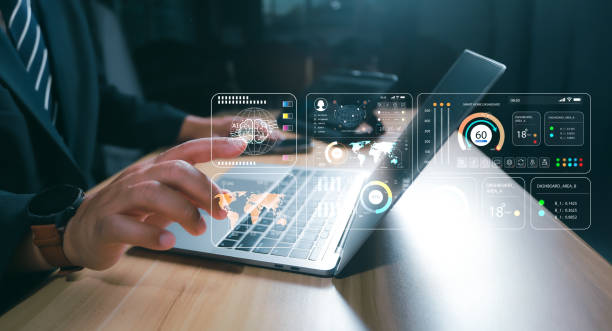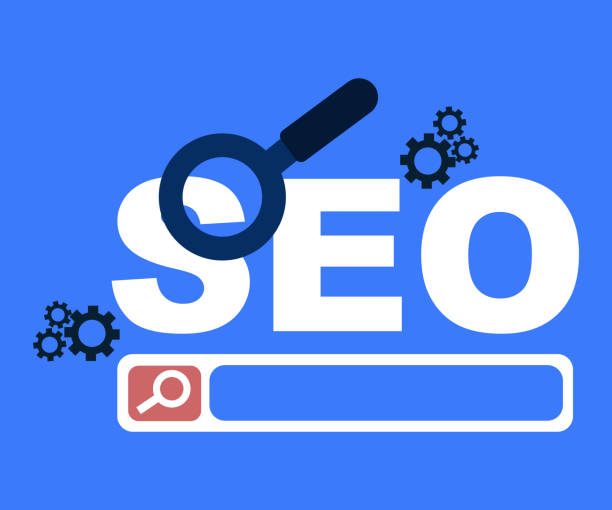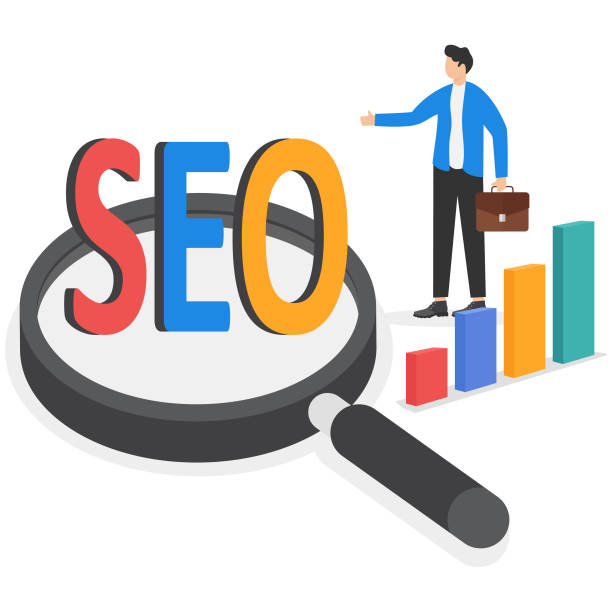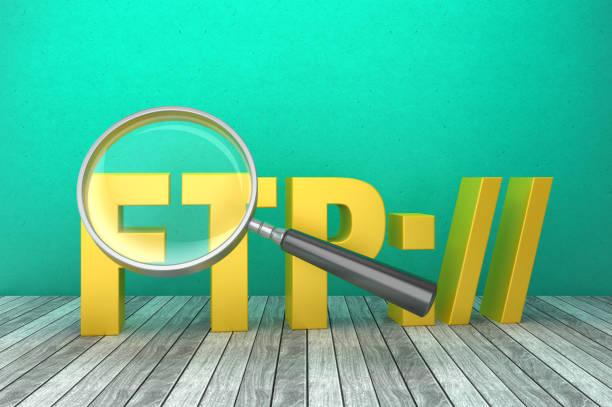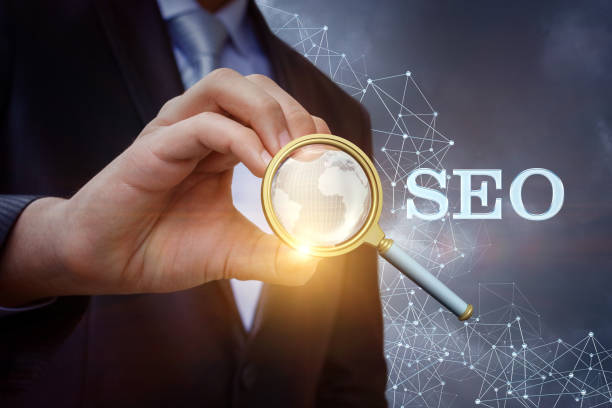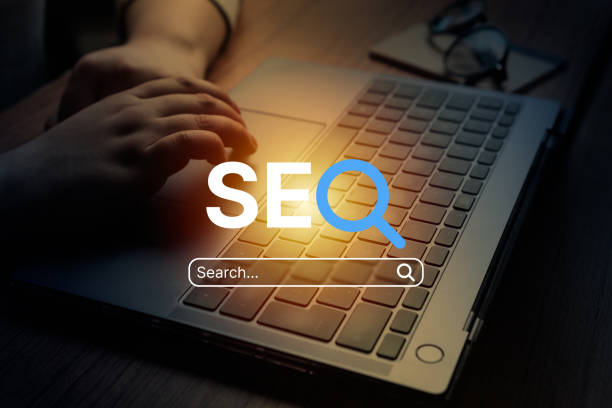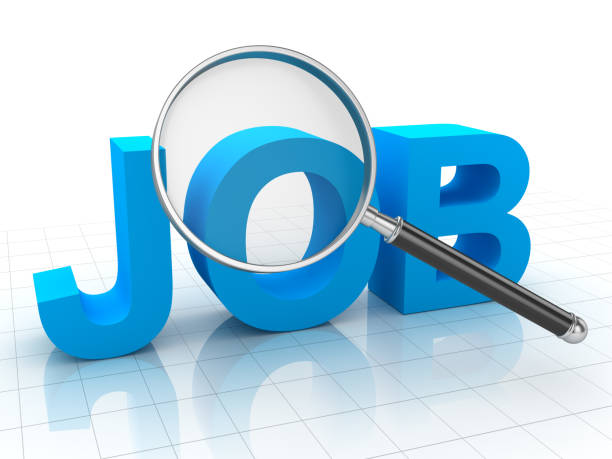What is On-Page SEO and Why is it Crucial for Your Website?
#On_Page_SEO, also known as On-Page SEO, refers to a set of actions performed within a website and on its pages to improve its ranking in search engine results.
These actions include content optimization, HTML code, and the overall site structure to attract more organic traffic.
Unlike off-page SEO which deals with backlinks and off-site activities, on-page SEO is entirely within your control and is the first step towards success in the competitive online world.
One of the most important reasons for the importance of on-page SEO is that it helps search engines better understand your content and recognize its value.
Without a strong on-page SEO strategy, even the best content may never reach its audience.
This part of SEO acts as an explainer and guide for search engine crawlers to correctly understand the connection between keywords, page content, and user intent.
Optimizing internal pages also leads to an improved user experience; as organized content, fast loading speed, and easy navigation keep users on your site for longer.
Ultimately, the ultimate goal of on-page SEO is to increase your site’s visibility in SERP (Search Engine Results Pages) and attract targeted traffic, which in turn means increasing the chance of converting visitors into customers.
Frustrated with your e-commerce site’s low conversion rate? Rasawab transforms your online store into a powerful tool for attracting and converting customers!
✅ Significant increase in visitor-to-buyer conversion rate
✅ Unparalleled user experience for increased customer satisfaction and loyalty⚡ Get a free consultation from Rasawab!
Effective Keyword Research to Boost Your On-Page SEO Power
#Keyword_Research is the backbone of any successful on-page SEO strategy.
Before any optimization efforts, you need to know what phrases your users search for to find your products or services.
This process involves identifying the words and phrases your target audience types into search engines.
Beyond simply identifying high-volume keywords, understanding the user’s “Search Intent” is critically important; is the user looking for information (informational keywords), intending to buy (commercial keywords), or searching for a specific website (navigational keywords)? Tools like Google Keyword Planner, Ahrefs, SEMrush, and KWFinder can help you identify relevant keywords, check search volume, competition level, and LSI (Latent Semantic Indexing) keyword suggestions.
Choosing the right keywords allows you to create content that precisely addresses audience needs while being well-indexed by search engines.
Long-tail Keywords, which consist of three or more words, usually have lower search volume but indicate a more specific search intent and have higher conversion rates.
By focusing on these keywords, you can attract much more targeted traffic to your site.
After selecting keywords, you should use them naturally and logically within your content, rather than simply repeating them, which is called “Keyword Stuffing” and will have a negative outcome.
Accurate keyword research paves the way for other on-page SEO actions.
Optimizing Title Tags and Meta Descriptions to Enhance Your Site’s On-Page SEO
#Title_Tag and #Meta_Description are among the most important elements in on-page SEO that directly impact your Click-Through Rate (CTR) in Search Engine Results Pages (SERP).
The title tag is the main title of your page, displayed in the browser tab and as the largest blue heading in Google results.
It should include the main keyword of the page and have a maximum length of 50 to 60 characters to be fully displayed.
This title should be engaging, accurate, and descriptive to encourage users to click.
Meta descriptions are also a brief summary of the page content that appears below the title in the SERP.
Although meta descriptions do not have a direct impact on ranking, they can significantly affect the click-through rate, as they are the first thing a user reads after the title.
These descriptions should be between 150 to 160 characters, include the main keyword, and have an engaging Call to Action to encourage users to visit your page.
Using keywords in the title tag and meta description helps search engines better understand the relevance of your content to the user’s search.
Precise optimization of these two elements sends strong signals of relevance and quality of your content to search engines, increasing the chances of your link being seen and clicked.
Below is a table of do’s and don’ts for this part of on-page SEO.
| Element | Do’s | Don’ts |
|---|---|---|
| Title Tag | Should include the main keyword, 50-60 characters, engaging and accurate. | Too long, keyword stuffing, vague or irrelevant. |
| Meta Description | Engaging summary of content, 150-160 characters, includes keyword, call to action. | Too short or long, repetitive for different pages, irrelevant to content. |
Creating Valuable and On-Page SEO-Oriented Content for Users and Search Engines
#Quality_Content is the beating heart of any successful on-page SEO strategy.
Today, search engines are increasingly focusing on the quality and relevance of content to user intent.
Producing content that is both engaging and useful for users, and understandable for search engines, is an art and a science.
Your content should be in-depth, comprehensive, and unique, answering users’ questions.
To this end, use appropriate headings (H1, H2, H3, …) to organize content and increase readability.
Short paragraphs, bulleted lists, and relevant images can improve the user experience.
Incorporate your primary and secondary keywords naturally into the text, especially at the beginning of paragraphs and in subheadings.
However, strictly avoid excessive repetition of keywords (Keyword Stuffing), as this will not only not help your ranking but may also lead to penalties.
Creating long-form content (more than 1000 words) can help you rank for more keywords and attract backlinks, provided its quality is maintained.
Furthermore, your content should be up-to-date and informative.
Regularly updating old articles with new information and fresh statistics can help maintain rankings and build trust with search engines.
Ultimately, adding value for the user should be your main priority; because search engines are increasingly incorporating user experience signals (such as dwell time on page and bounce rate) into their ranking algorithms.
Does your current website reflect your brand’s credibility as it should? Or does it drive away potential customers?
Rasawab, with years of experience in professional corporate website design, is your comprehensive solution.
✅ A modern, beautiful website tailored to your brand identity
✅ Significant increase in lead and new customer acquisition
⚡ Contact Rasawab now for a free corporate website design consultation!
Image Optimization for Increased Speed and Improved On-Page SEO
#Image_SEO is an important part of the on-page SEO strategy that is often overlooked, but plays a vital role in site loading speed and improving visibility in image search results.
Large image files can severely slow down page loading speed, which is a significant factor in ranking and a negative user experience.
To optimize images, you first need to reduce their size without severely compromising image quality.
Formats like WebP are more optimized for the web, but JPEG and PNG can also be used with proper compression.
Use online image compression tools or CMS plugins for this purpose.
Image file names should be descriptive and include relevant keywords (e.g., instead of `IMG_001.jpg`, use `seo-dakheli-image-optimization.jpg`).
Alt tags (Alternate Text) are also very important.
This descriptive text helps search engines understand the content of the image and is also useful for visually impaired users.
The Alt tag should include relevant keywords, but avoid excessive keyword repetition and be descriptive and natural.
Also, adding a caption to images helps improve the user experience and users’ understanding of the content.
Consider the dimensions of the images to match their display space so that the browser does not have to resize them during loading.
Optimizing images not only helps improve on-page SEO but also provides a better user experience by increasing site speed and can lead to a reduced bounce rate and increased user dwell time on the site.
Click here to preview your posts with PRO themes ››
URL Structure and Internal Linking: Keys to Success in On-Page SEO
#URL_Structure and #Internal_Linking are two important and inseparable elements in on-page SEO optimization that help search engines and users better understand your site’s structure.
A good URL should be short, descriptive, and include keywords relevant to the page’s content.
Avoid special characters, meaningless numbers, and long, incomprehensible phrases in your URL.
Using hyphens (-) instead of underscores (_) to separate words in URLs is recommended, as search engines recognize hyphens as word separators.
Internal linking is the process of creating links from one page on your site to another page on the same site.
This helps search engines discover and index your site’s pages and distributes value (Link Equity) throughout your site.
Additionally, internal links help users easily navigate your site and find related content, which leads to an improved user experience.
Using descriptive and keyword-relevant Anchor Texts for internal links is very important.
For example, instead of “click here,” use “complete on-page SEO guide.”
Make sure your important and highly visited pages have more internal links from other pages on the site.
This gives them a stronger signal of authority.
Also, avoid linking to Orphan Pages that have no internal links to them, as search engines may not discover them.
A logical and hierarchical internal linking structure not only helps Google crawlers better navigate and index the site, but also allows users to easily access the information they need and ultimately improves your site’s ranking in search results.
This on-page SEO optimization is a crucial step in creating a powerful and user-friendly site.
Technical Aspects of On-Page SEO: Improving Speed and Mobile Experience
#Technical_SEO is the strong foundation for a successful on-page SEO strategy.
Technical aspects, though less visible, play a vital role in how your site is crawled, indexed, and ranked by search engines.
Website loading speed is one of the most important ranking factors, especially with the introduction of Core Web Vitals by Google.
Slow sites not only provide a poor user experience but also have a higher bounce rate.
To improve speed, use image compression, browser caching, content delivery networks (CDN), and CSS and JavaScript code optimization.
Mobile-Friendliness of the site is another critical factor.
Given the significant increase in mobile searches, Google primarily considers the mobile version of your site for indexing and ranking (Mobile-First Indexing).
Your site must be fully responsive and display its content without issues on all devices and screen sizes.
Technical issues such as 404 errors, broken links, problems with Robots.txt or Sitemap.xml files can also seriously affect your on-page SEO performance.
Regularly checking for and fixing these errors through Google Search Console is essential.
Using Structured Data such as Schema Markup can also help search engines better understand your content and display it as Rich Snippets in search results, which in turn increases the click-through rate.
Click here to preview your posts with PRO themes ››
| Technical Factor | Importance for On-Page SEO | Monitoring Tools |
|---|---|---|
| Website Loading Speed | Crucial ranking factor, improved user experience, reduced bounce rate. | PageSpeed Insights, GTmetrix, Lighthouse |
| Mobile Compatibility | Mobile-first indexing, improved UX for mobile users. | Google Mobile-Friendly Test, Search Console |
| Structured Data | Displaying Rich Snippets, better content understanding by search engines. | Schema Markup Validator, Rich Results Test |
The Role of User Experience (UX) in Modern On-Page SEO Strategies
#User_Experience (UX) has gradually become one of the most important factors in on-page SEO.
Keywords and backlinks alone are no longer enough; search engines like Google are increasingly relying on user behavioral signals to determine a page’s ranking.
These signals include Bounce Rate, Dwell Time, Click-Through Rate (CTR), and the number of pages visited per session.
An excellent user experience means that users can easily navigate your site, quickly access the information they need, and enjoy interacting with your content.
If users quickly leave your site (high bounce rate) or spend little time on it (low Dwell Time), this sends a negative signal to search engines that your content has not adequately answered the user’s search intent, and may lead to a lower ranking.
To improve UX in line with on-page SEO, ensure your site has an attractive visual design, easy navigation, readable content (using appropriate font, line size, white space), and fast loading speed.
Clear and logical Calls to Action (CTAs) also guide users along your desired path.
Additionally, improving site Responsiveness for all devices is essential.
Google directly measures user experience with its Core Web Vitals factors, which include LCP (Largest Contentful Paint), FID (First Input Delay), and CLS (Cumulative Layout Shift).
Meeting these criteria means providing a smooth and pleasant user experience, which in turn helps increase your ranking in search results.
Therefore, a comprehensive on-page SEO strategy should pay as much attention to user experience as it does to technical and content factors.
Did you know that 94% of a first impression of a company is related to its website design?
Rasawab, offering professional corporate website design services, helps you create the best first impression.
✅ Creating a professional and trustworthy image for your brand
✅ Easier attraction of potential customers and improved online presence
⚡ Get a free corporate website design consultation
Measuring and Continuously Improving On-Page SEO with Analytical Tools
#SEO_Analytics and continuous monitoring of on-page SEO performance are crucial to ensuring the effectiveness of strategies and identifying opportunities for improvement.
Without measurement, you cannot know which of your actions have been successful and which need optimization.
Google Analytics and Google Search Console are two free and powerful tools from Google that provide invaluable information about your site’s performance.
Google Analytics allows you to monitor site traffic, referral sources, user behavior on the site (such as bounce rate, dwell time, visit path), and conversion rate.
This data can indicate whether your content is adequately meeting user needs.
On the other hand, Google Search Console is an essential tool for monitoring your site’s SEO performance in search results.
This tool provides information about the keywords users used to find your site, the number of clicks and impressions, average ranking position, crawl errors, indexing issues, mobile compatibility problems, and Core Web Vitals status.
By regularly using these tools, you can identify poorly performing pages, fix technical issues, and discover new opportunities for keyword and content optimization.
Additionally, paid tools like Ahrefs and SEMrush provide deeper insights into backlinks, competitor analysis, and keyword opportunities.
Data analysis helps you make data-driven decisions and continuously improve your on-page SEO strategy to always stay one step ahead of the competition.
This continuous improvement process will guarantee top rankings and consistent traffic for your website.
Future Trends and Advanced On-Page SEO Strategies
#Future_SEO is rapidly evolving, and with the emergence of new technologies and changing user behavior, on-page SEO strategies must keep pace with these changes.
One of the most important future trends is the increasing importance of Artificial Intelligence (AI) in Google’s algorithms.
Algorithms like RankBrain and BERT, and more recently MUM, help Google understand search intent with greater accuracy and provide more relevant and high-quality content.
This means that focusing on producing truly useful, comprehensive, and authoritative content that answers complex user questions will become even more crucial.
Another important trend is Voice Search.
With the widespread use of voice assistants like Google Assistant and Siri, users are increasingly using longer, conversational questions.
To optimize for voice search, you need to include conversational and question-based keywords in your content and answer frequently asked questions.
Click here to preview your posts with PRO themes ››
Furthermore, Video SEO has also gained increasing importance.
With the rise in video content consumption, optimizing videos for search engines, including using keywords in titles, descriptions, tags, and adding subtitles and transcripts, can be a major source of traffic.
Also, optimizing for Google Discover, which displays relevant and personalized content to users without them having to search, is an excellent opportunity to gain organic traffic.
This requires producing very high-quality, up-to-date, and engaging content.
Ultimately, on-page SEO is no longer just about keywords, but a deeper understanding of user behavior, addressing their needs, and adapting to more intelligent search engine algorithms, which paves the way for success.
By staying up-to-date with these trends and implementing advanced strategies, you can secure your position in the world of SEO.
Frequently Asked Questions
| Question | Answer |
|---|---|
| What is On-page SEO? | On-page SEO refers to a set of actions performed within your website to improve its ranking in search engine results. This includes optimizing content, site structure, and HTML code. |
| Why is On-page SEO important? | On-page SEO helps search engines understand your page’s content and determine whether your content is relevant to searchers. It is the foundation of any successful SEO strategy. |
| What are the key elements of On-page SEO? | Page title (Title Tag), Meta Description, keyword usage, image optimization, heading structure (H1, H2, …), internal linking, and content quality are key elements. |
| How do we optimize the Page Title (Title Tag)? | The page title should include the main keyword, be engaging and encouraging to click, and be between 50 to 60 characters (or appropriate pixels) in length to be fully displayed in search results. |
| What role does Meta Description play in On-page SEO? | The meta description is a summary of the page content displayed below the title in search results. Although it does not directly affect ranking, it helps SEO by increasing the click-through rate (CTR). |
| What is the importance of using a heading structure (H1, H2, H3) in On-page SEO? | Headings structure the page content and make it easier to read. H1 is typically the main title of the page and should include the keyword. H2 and H3 are used to organize subsections and help search engines understand the content hierarchy. |
| How to effectively use keywords in content? | Keywords should be used naturally and logically throughout the content, including the introduction, body, and conclusion. Avoid excessive keyword stuffing. |
| What steps are involved in optimizing images for On-page SEO? | It includes compressing images to reduce size, using descriptive file names, adding appropriate alternative text (Alt Text), and optimizing the image title and description. Alt Text is crucial for accessibility and helping search engines understand image content. |
| What is Internal Linking and what are its benefits? | Internal linking means creating links from one page on your website to another page on the same website. This helps users navigate your site easily, distributes page authority across the site, and helps search engines better understand your site’s structure. |
| What is the importance of content quality in On-page SEO? | High-quality, accurate, comprehensive, and valuable content for users is the cornerstone of on-page SEO. Search engines prefer content that meets user needs. Quality content leads to longer user dwell time on the site and a reduced bounce rate, which are positive SEO signals. |
And other advertising services from Rasawab Advertising Agency
Smart Link Building: A combination of creativity and technology to improve SEO ranking through SEO-driven content strategy.
Smart Digital Advertising: A combination of creativity and technology to increase click-through rates through Google Ads management.
Smart Social Media: A creative platform for improving SEO ranking by optimizing key pages.
Smart Sales Automation: A fast and efficient solution for increasing click-through rates with a focus on attractive user interface design.
Smart Conversion Rate Optimization: An effective tool for digital branding with the help of custom programming.
And hundreds of other services in the field of internet advertising, advertising consultation, and organizational solutions
Internet Advertising | Advertising Strategy | Advertorial
Sources
Iran SEO Blog
MihanWP SEO Guide
SEO on Namnak Website
SEO Tips on Limoo
? For your business to leap forward in the digital world and experience unparalleled growth, Rasawab Afarin is your smart companion. With our expertise in SEO, content marketing, and especially user-friendly website design, you will have a powerful and lasting presence on the web.
📍 Tehran, Mirdamad Street, next to Bank Markazi, Southern Kazeroon Alley, Ramin Alley, No. 6



